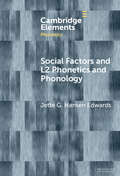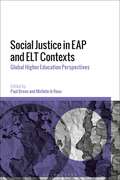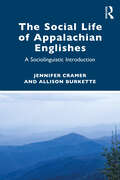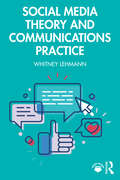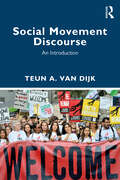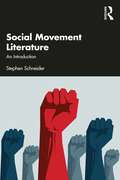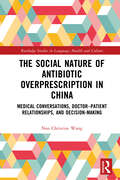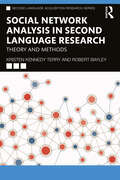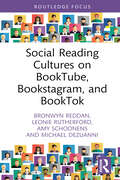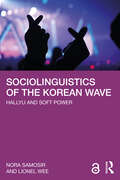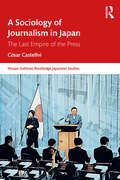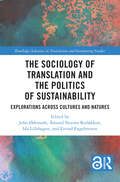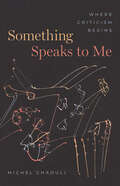- Table View
- List View
Social Factors and L2 Phonetics and Phonology (Elements in Phonetics)
by null Jette G. Hansen EdwardsThis Element provides readers with a detailed overview of the social factors that affect second language (L2) phonology acquisition and use. Through a state-of-the art synthesis of the relevant literature, this Element addresses the following questions: What do we mean by social factors? Which social factors have been investigated in research on L2 phonological acquisition and use? How and why do social factors affect L2 phonological acquisition (production and perception) and use? What are the implications of the social factor findings for teaching L2 pronunciation? The Element answers these questions through a synthesis of key findings in research on social factors and L2 phonology. Conclusions and implications for teaching, as well as key readings and references, follow the research synthesis.
Social Justice in EAP and ELT Contexts: Global Higher Education Perspectives
by Paul Breen and Michèle le RouxThis book articulates an understanding of what is meant by the term social justice from a global perspective, drawing upon examples of practice from across a range of English for academic purposes (EAP) and English language teaching (ELT) higher education contexts. Presently, within western higher educational systems, there is a drive for greater integration of approaches that lend themselves to social justice. However, questions still remain about what that means in practice. This book seeks to answer that not by telling but by showing. It presents a series of chapters that act as vignettes into a diverse set of classrooms, contexts and countries, offering examples of how and where an epistemology of social justice has been put into practice in teaching and learning situations. Such situations range from cross-continental higher educational partnerships between east and west to instances of EAP practitioners' work with refugees from North Africa and the Middle East. These examples are threaded together by the common goal of understanding what it is that defines an enactment of social justice and what the shared denominators are across these contexts. Through looking at these various examples, the authors produce a set of codes and themes that are common to practice across contexts and discuss how these might help inform practice in other areas of language education, higher education and educational development work in general.
The Social Life of Appalachian Englishes: A Sociolinguistic Introduction
by Jennifer Cramer Allison BurketteAppalachian Englishes (AEs) possess an array of linguistic features that distinguish them from other American Englishes, yet the rich history of language in the United States has created a wealth of linguistic resources through factors such as immigration and contact, providing the environment for AEs to grow and adapt in ways that are also similar to other varieties of English. AEs have a long history of representation in linguistic literature, but until now no single work has examined the interplay of language production and perception with an eye toward the role that language plays in the construction of personal and social identities.The Social Life of Appalachian Englishes takes a sociolinguistic/sociocultural approach to exploring specific linguistic features highlighted in the Linguistic Atlas Projects and the social life of Appalachian varieties in terms of perceptions and use. Focusing on the single theme of the social life of language in Appalachia, the book aims to explore the implications of the kinds of variation found, reinforce the notion that social meaning and variation are inseparable, and illustrate how linguistic production and perception are interrelated. It uses new data to amplify this theme, presenting a novel combination of data from different sociolinguistic traditions (specifically, perceptual dialectology and traditional atlas-style dialectology). Opportunities for engagement are provided through QR codes linking to additional resources and discussion questions and exercises at the end of each chapter.This book is designed for students and researchers interested in general linguistics, sociolinguistics, American Englishes, language variation, linguistic anthropology, and Appalachian studies.
The Social Life of Appalachian Englishes: A Sociolinguistic Introduction
by Jennifer Cramer Allison BurketteAppalachian Englishes (AEs) possess an array of linguistic features that distinguish them from other American Englishes, yet the rich history of language in the United States has created a wealth of linguistic resources through factors such as immigration and contact, providing the environment for AEs to grow and adapt in ways that are also similar to other varieties of English. AEs have a long history of representation in linguistic literature, but until now no single work has examined the interplay of language production and perception with an eye toward the role that language plays in the construction of personal and social identities.The Social Life of Appalachian Englishes takes a sociolinguistic/sociocultural approach to exploring specific linguistic features highlighted in the Linguistic Atlas Projects and the social life of Appalachian varieties in terms of perceptions and use. Focusing on the single theme of the social life of language in Appalachia, the book aims to explore the implications of the kinds of variation found, reinforce the notion that social meaning and variation are inseparable, and illustrate how linguistic production and perception are interrelated. It uses new data to amplify this theme, presenting a novel combination of data from different sociolinguistic traditions (specifically, perceptual dialectology and traditional atlas-style dialectology). Opportunities for engagement are provided through QR codes linking to additional resources and discussion questions and exercises at the end of each chapter.This book is designed for students and researchers interested in general linguistics, sociolinguistics, American Englishes, language variation, linguistic anthropology, and Appalachian studies.
Social Media Theory and Communications Practice
by Whitney LehmannFusing the academic with the applied, this book provides a comprehensive introduction to social media for future communications professionals.While most social media texts approach the subject through either a theoretical, scholarly lens or a professional, practical lens, this text offers a much-needed linkage of theory to the practical tactics employed by social media communicators. Concise and conversational chapters break down the basics of both social media theory and practice and are complemented by sidebars written by scholars and industry professionals, chapter summaries and end-of-chapter exercises.This book is ideal for introductory social media courses in communication, public relations and mass communication departments, as well as courses in digital media and public relations.Online resources include social media writing templates, sample posts and content calendar templates. Please visit www.routledge.com/9781032185873.
Social Media Theory and Communications Practice
by Whitney LehmannFusing the academic with the applied, this book provides a comprehensive introduction to social media for future communications professionals.While most social media texts approach the subject through either a theoretical, scholarly lens or a professional, practical lens, this text offers a much-needed linkage of theory to the practical tactics employed by social media communicators. Concise and conversational chapters break down the basics of both social media theory and practice and are complemented by sidebars written by scholars and industry professionals, chapter summaries and end-of-chapter exercises.This book is ideal for introductory social media courses in communication, public relations and mass communication departments, as well as courses in digital media and public relations.Online resources include social media writing templates, sample posts and content calendar templates. Please visit www.routledge.com/9781032185873.
Social Movement Discourse: An Introduction
by Teun A. van DijkThis is both the first systematic introduction to Discourse Studies for students and scholars of social movements and a study of discourses on the European “refugee crisis”, by leading theorist, Teun A. van Dijk.Concrete examples of different kinds of discourse are vital for the study of social movements because their activities are not limited to such well-known forms of contention as marches, occupations or strikes, but also daily discursive activities, such as meetings, assemblies, interviews, press conferences, manifestos, pamphlets, banners, graffiti, websites, blogs, social media posts and everyday talk.This book proposes that empirical analyses of these discourses should go beyond the popular but vague notion of “frame”and engage in more detailed and explicit analyses of the text and talk of social movements.This is a much-needed introduction to the most important structures of discourse and a detailed theoretical account of the notion of “solidarity” defining the Refugees Welcome movement.
Social Movement Discourse: An Introduction
by Teun A. van DijkThis is both the first systematic introduction to Discourse Studies for students and scholars of social movements and a study of discourses on the European “refugee crisis”, by leading theorist, Teun A. van Dijk.Concrete examples of different kinds of discourse are vital for the study of social movements because their activities are not limited to such well-known forms of contention as marches, occupations or strikes, but also daily discursive activities, such as meetings, assemblies, interviews, press conferences, manifestos, pamphlets, banners, graffiti, websites, blogs, social media posts and everyday talk.This book proposes that empirical analyses of these discourses should go beyond the popular but vague notion of “frame”and engage in more detailed and explicit analyses of the text and talk of social movements.This is a much-needed introduction to the most important structures of discourse and a detailed theoretical account of the notion of “solidarity” defining the Refugees Welcome movement.
Social Movement Literature: An Introduction
by Stephen SchneiderSocial Movement Literature introduces readers to the study of those cultural texts that have come to define modern social movements. Looking at movements such as the US civil rights movement, gay liberation movement, environmental movement, and contemporary movement such as #metoo and Black Lives Matter, this volume focuses not just on the texts that social movements have produced, but also on those that have inspired and been inspired by those movements. As such, Social Movement Literature seeks to address a number of key questions: how do social movements develop and present not just their goals, but also their broader identities, using texts and other media? How are these movement texts received and further disseminated? Are there common features across movement texts? How and why do some of these texts continue to resonate today? By combining both textual and historical approaches to the analysis of social movements, this volume aims to give readers both an understanding of how social movements emerge and why they remain both political and culturally relevant today.
Social Movement Literature: An Introduction
by Stephen SchneiderSocial Movement Literature introduces readers to the study of those cultural texts that have come to define modern social movements. Looking at movements such as the US civil rights movement, gay liberation movement, environmental movement, and contemporary movement such as #metoo and Black Lives Matter, this volume focuses not just on the texts that social movements have produced, but also on those that have inspired and been inspired by those movements. As such, Social Movement Literature seeks to address a number of key questions: how do social movements develop and present not just their goals, but also their broader identities, using texts and other media? How are these movement texts received and further disseminated? Are there common features across movement texts? How and why do some of these texts continue to resonate today? By combining both textual and historical approaches to the analysis of social movements, this volume aims to give readers both an understanding of how social movements emerge and why they remain both political and culturally relevant today.
The Social Nature of Antibiotic Overprescription in China: Medical Conversations, Doctor–Patient Relationships, and Decision-Making (Routledge Studies in Language, Health and Culture)
by Nan Christine WangOffering a rarely seen glimpse into the realities of one of the biggest global public health crises in modern time, Wang’s book focuses on doctor–patient interactions in China to demonstrate the potential effects of health communication, doctor–patient relationship, and a matrix of social factors on overprescription of antibiotics.Based on a community-based survey, the book describes empirical findings regarding the high prevalence of non-prescribed antibiotics use for common colds among children in China. It covers the potential effects of overprescription on caregivers' attitudes and how physicians make prescribing decisions in medical consultations. Drawing from evidence in medical interaction data, readers are introduced to further empirical findings regarding the communicative behaviors that patient caregivers use to pressure for antibiotic prescriptions in real medical consultations. Following this, Wang reports findings regarding the communicative behaviors that physicians use to make treatment recommendations and caregivers use to launch treatment negotiations, leading to a discussion of the effect of the doctor–patient relationship on antibiotic overprescription. The book culminates in practice recommendations and provides teaching scenarios in which physicians successfully engage the caregivers into conversations to shape their expectations for antibiotic prescriptions in medical consultations.An important resource for scholars and students in health communication, linguistics, medical humanities, and medical sociology. Practitioners who are interested in understanding and improving clinical practices as well as policymakers aiming to combat antibiotic resistance will also find this book useful.
The Social Nature of Antibiotic Overprescription in China: Medical Conversations, Doctor–Patient Relationships, and Decision-Making (Routledge Studies in Language, Health and Culture)
by Nan Christine WangOffering a rarely seen glimpse into the realities of one of the biggest global public health crises in modern time, Wang’s book focuses on doctor–patient interactions in China to demonstrate the potential effects of health communication, doctor–patient relationship, and a matrix of social factors on overprescription of antibiotics.Based on a community-based survey, the book describes empirical findings regarding the high prevalence of non-prescribed antibiotics use for common colds among children in China. It covers the potential effects of overprescription on caregivers' attitudes and how physicians make prescribing decisions in medical consultations. Drawing from evidence in medical interaction data, readers are introduced to further empirical findings regarding the communicative behaviors that patient caregivers use to pressure for antibiotic prescriptions in real medical consultations. Following this, Wang reports findings regarding the communicative behaviors that physicians use to make treatment recommendations and caregivers use to launch treatment negotiations, leading to a discussion of the effect of the doctor–patient relationship on antibiotic overprescription. The book culminates in practice recommendations and provides teaching scenarios in which physicians successfully engage the caregivers into conversations to shape their expectations for antibiotic prescriptions in medical consultations.An important resource for scholars and students in health communication, linguistics, medical humanities, and medical sociology. Practitioners who are interested in understanding and improving clinical practices as well as policymakers aiming to combat antibiotic resistance will also find this book useful.
Social Network Analysis in Second Language Research: Theory and Methods (ISSN)
by Kristen Kennedy Terry Robert BayleyThis text is the first holistic research overview and practical methodological guide for social network analysis in second language acquisition, examining how to study learner social networks and how to use network data to predict language learner behavior and identity.Authors Kristen Kennedy Terry and Robert Bayley lay out the history of social network analysis in sociolinguistics, discuss the state of the art in empirical findings in applications to language acquisition, offer how-to guidance and best practices for planning, conducting, and understanding this research, and authoritatively set the agenda for future work.With a variety of helpful features like case studies, suggested research projects, discussion questions, and recommended further reading, this book will be an invaluable resource to students and researchers of second language acquisition, sociolinguistics, education, and beyond.
Social Network Analysis in Second Language Research: Theory and Methods (ISSN)
by Kristen Kennedy Terry Robert BayleyThis text is the first holistic research overview and practical methodological guide for social network analysis in second language acquisition, examining how to study learner social networks and how to use network data to predict language learner behavior and identity.Authors Kristen Kennedy Terry and Robert Bayley lay out the history of social network analysis in sociolinguistics, discuss the state of the art in empirical findings in applications to language acquisition, offer how-to guidance and best practices for planning, conducting, and understanding this research, and authoritatively set the agenda for future work.With a variety of helpful features like case studies, suggested research projects, discussion questions, and recommended further reading, this book will be an invaluable resource to students and researchers of second language acquisition, sociolinguistics, education, and beyond.
Social Reading Cultures on BookTube, Bookstagram, and BookTok
by Bronwyn Reddan Leonie Rutherford Amy Schoonens Michael DezuanniThis book examines the reading cultures developed by communities of readers and book lovers on BookTube, Bookstagram, and BookTok as an increasingly important influence on contemporary book and literary culture. It explores how the affordances of social media platforms invite readers to participate in social reading communities and engage in creative and curatorial practices that express their identity as readers and book lovers.The interdisciplinary team of authors argue that by creating new opportunities for readers to engage in social reading practices, bookish social media has elevated the agency and visibility of readers and book consumers within literary culture. It has also reshaped the cultural and economic dynamics of book recommendations by creating a space in which different actors are able to form an identity as mediators of reading culture.Concise and accessible, this introduction to an increasingly central set of literary practices is essential reading for students and scholars of literature, sociology, media, and cultural studies, as well as teachers and professionals in the book and library industries.
Social Reading Cultures on BookTube, Bookstagram, and BookTok
by Bronwyn Reddan Leonie Rutherford Amy Schoonens Michael DezuanniThis book examines the reading cultures developed by communities of readers and book lovers on BookTube, Bookstagram, and BookTok as an increasingly important influence on contemporary book and literary culture. It explores how the affordances of social media platforms invite readers to participate in social reading communities and engage in creative and curatorial practices that express their identity as readers and book lovers.The interdisciplinary team of authors argue that by creating new opportunities for readers to engage in social reading practices, bookish social media has elevated the agency and visibility of readers and book consumers within literary culture. It has also reshaped the cultural and economic dynamics of book recommendations by creating a space in which different actors are able to form an identity as mediators of reading culture.Concise and accessible, this introduction to an increasingly central set of literary practices is essential reading for students and scholars of literature, sociology, media, and cultural studies, as well as teachers and professionals in the book and library industries.
Sociocultural Theory and Second Language Developmental Education (Elements in Language Teaching)
by null Matthew E. Poehner null James P. LantolfSociocultural Theory (SCT), as formulated by Russian psychologist L. S. Vygotsky nearly a century ago, is distinct among traditions in the field of second language (L2) studies in its commitment to praxis. According to this view, theory and research provide the orienting basis for practice, which in turn serves as a testing ground for theory (Vygotsky, 1997). This Element offers a synthesis of foundational concepts and principles of SCT and an overview of two important areas of praxis in L2 education: Concept-Based Language Instruction, which organizes language curricula around linguistic concepts, and Dynamic Assessment, a framework that integrates teaching and diagnosing learner L2 abilities. Leading approaches to L2 teacher education informed by SCT are also discussed. Examples from studies with L2 teachers and learners showcase praxis in action, and emerging questions and directions are considered.
Sociolinguistics of the Korean Wave: Hallyu and Soft Power
by Nora Samosir Lionel WeeSamosir and Wee examine how the immensely popular Korean Wave ("K-wave") also known as Hallyu is wielded as soft power through the use of communication for persuasion and attraction on the global stage. The Korean Wave refers to the global spread and popularity of South Korean culture, particularly its pop music ("K-pop"), serialised dramas ("K-dramas") and films ("K-films"). Given the South Korean government’s involvement in providing funding and publicity, the Korean Wave raises interesting sociolinguistic questions about the relationship between artistry and citizenship, the use of social media in facilitating the consumption of cultural products, and, ultimately, the nature of soft power itself. Studies of soft power have tended to come from the field of international relations. This book shows that sociolinguistics actually has a number of tools in its conceptual arsenal – such as indexicality, stance taking, affect, and styling – that can shed light on the Korean Wave as a form of soft power. As the first book-length sociolinguistic analysis of the Korean Wave and soft power, this book demonstrates how K-pop, K-dramas, and K-films have been able to encourage in consumers an anthropological stance towards all things Korean. This volume will be of particular interest to students and scholars in sociolinguistics, political science, cultural studies, and Korean studies.
Sociolinguistics of the Korean Wave: Hallyu and Soft Power
by Nora Samosir Lionel WeeSamosir and Wee examine how the immensely popular Korean Wave ("K-wave") also known as Hallyu is wielded as soft power through the use of communication for persuasion and attraction on the global stage. The Korean Wave refers to the global spread and popularity of South Korean culture, particularly its pop music ("K-pop"), serialised dramas ("K-dramas") and films ("K-films"). Given the South Korean government’s involvement in providing funding and publicity, the Korean Wave raises interesting sociolinguistic questions about the relationship between artistry and citizenship, the use of social media in facilitating the consumption of cultural products, and, ultimately, the nature of soft power itself. Studies of soft power have tended to come from the field of international relations. This book shows that sociolinguistics actually has a number of tools in its conceptual arsenal – such as indexicality, stance taking, affect, and styling – that can shed light on the Korean Wave as a form of soft power. As the first book-length sociolinguistic analysis of the Korean Wave and soft power, this book demonstrates how K-pop, K-dramas, and K-films have been able to encourage in consumers an anthropological stance towards all things Korean. This volume will be of particular interest to students and scholars in sociolinguistics, political science, cultural studies, and Korean studies.
A Sociology of Journalism in Japan: The Last Empire of the Press (ISSN)
by César CastellviThis book represents an in-depth analysis of journalism in Japan during the golden era of the daily press and the gradual introduction of digital technology starting from the mid-1980s to the late 2010s.By presenting firsthand testimony from journalists and field notes collected from fieldwork in the newsroom of one of the country's largest newspapers, this book provides a unique insight into Japan’s highly active yet relatively under-institutionalized journalistic profession. It also explores the changes experienced by the organizational development of Japanese journalism in response to broader changes in Japanese society, such as the emergence of social networks, the evolution of reading practices, the demographic situation, and the new aspirations of the Japanese youth.Based on an extensive ethnographic fieldwork carried out by the author over several years, this book will be of huge interest to students and scholars of Japanese society, journalism, and media studies.
A Sociology of Journalism in Japan: The Last Empire of the Press (ISSN)
by César CastellviThis book represents an in-depth analysis of journalism in Japan during the golden era of the daily press and the gradual introduction of digital technology starting from the mid-1980s to the late 2010s.By presenting firsthand testimony from journalists and field notes collected from fieldwork in the newsroom of one of the country's largest newspapers, this book provides a unique insight into Japan’s highly active yet relatively under-institutionalized journalistic profession. It also explores the changes experienced by the organizational development of Japanese journalism in response to broader changes in Japanese society, such as the emergence of social networks, the evolution of reading practices, the demographic situation, and the new aspirations of the Japanese youth.Based on an extensive ethnographic fieldwork carried out by the author over several years, this book will be of huge interest to students and scholars of Japanese society, journalism, and media studies.
The Sociology of Translation and the Politics of Sustainability: Explorations Across Cultures and Natures (ISSN)
This book uses sustainability to explore the interfaces between translation studies, the cultural history of knowledge, and Science and Technology studies (STS).The volume examines various material, cultural and epistemic translation practices where sustainability serves as a boundary object between natural and cultural inquiry. By turning to the intellectual traditions that influenced but were left behind by STS and actor-network theory (ANT), we aim to challenge and expand the Sociology of Translation developed in ANT. Concepts such as ‘inscription’ (Derrida), ‘actant’, ‘narrative’ (Greimas), and ‘world/worlding’ (Heidegger, Spivak) were reemployed – translated – in the canonical STS-texts. What networks of meaning were left behind in this reemployment? The book showcases a combination of cultural and knowledge historical perspectives on the construction of the Sociology of Translation and practical experiments across the registers of nature and culture is novel. There have been brilliant individual attempts to realign the Sociology of Translation with narratives and modes of enunciation, but none has related the Sociology of Translation to the networks and traditions which enabled it but to which it erased its relations and debts.This innovative work will appeal to scholars in translation studies, cultural studies, environmental humanities, medical humanities, and Science and Technology studies.The Open Access version of this book, available at http://www.taylorfrancis.com, has been made available under a Creative Commons [Attribution-Non Commercial-No Derivatives (CC-BY-NC-ND)] 4.0 license.
The Sociology of Translation and the Politics of Sustainability: Explorations Across Cultures and Natures (ISSN)
by John Ødemark, Åmund Norum Resløkken, Ida Lillehagen, and Eivind EngebretsenThis book uses sustainability to explore the interfaces between translation studies, the cultural history of knowledge, and Science and Technology studies (STS).The volume examines various material, cultural and epistemic translation practices where sustainability serves as a boundary object between natural and cultural inquiry. By turning to the intellectual traditions that influenced but were left behind by STS and actor-network theory (ANT), we aim to challenge and expand the Sociology of Translation developed in ANT. Concepts such as ‘inscription’ (Derrida), ‘actant’, ‘narrative’ (Greimas), and ‘world/worlding’ (Heidegger, Spivak) were reemployed – translated – in the canonical STS-texts. What networks of meaning were left behind in this reemployment? The book showcases a combination of cultural and knowledge historical perspectives on the construction of the Sociology of Translation and practical experiments across the registers of nature and culture is novel. There have been brilliant individual attempts to realign the Sociology of Translation with narratives and modes of enunciation, but none has related the Sociology of Translation to the networks and traditions which enabled it but to which it erased its relations and debts.This innovative work will appeal to scholars in translation studies, cultural studies, environmental humanities, medical humanities, and Science and Technology studies.The Open Access version of this book, available at http://www.taylorfrancis.com, has been made available under a Creative Commons [Attribution-Non Commercial-No Derivatives (CC-BY-NC-ND)] 4.0 license.
Something Speaks to Me: Where Criticism Begins
by Michel ChaouliAn account of criticism as an urgent response to what moves us. Criticism begins when we put down a book to tell someone about it. It is what we do when we face a work or event that bowls us over and makes us scramble for a response. As Michel Chaouli argues, criticism involves three moments: Something speaks to me. I must tell you about it. But I don’t know how. The heart of criticism, no matter its form, lies in these surges of thoughts and feelings. Criticism arises from the fundamental need to share what overwhelms us. We tend to associate criticism with scholarship and journalism. But Chaouli is not describing professional criticism, but what he calls “poetic criticism”—a staging ground for surprise, dread, delight, comprehension, and incomprehension. Written in the mode of a philosophical essay, Something Speaks to Me draws on a wide range of writers, artists, and thinkers, from Kant and Schlegel to Merleau-Ponty, Bachelard, Barthes, and Cavell. Reflecting on these dimensions of poetic experience, Something Speaks to Me is less concerned with joining academic debates than communicating the urgency of criticism.
Something Speaks to Me: Where Criticism Begins
by Michel ChaouliAn account of criticism as an urgent response to what moves us. Criticism begins when we put down a book to tell someone about it. It is what we do when we face a work or event that bowls us over and makes us scramble for a response. As Michel Chaouli argues, criticism involves three moments: Something speaks to me. I must tell you about it. But I don’t know how. The heart of criticism, no matter its form, lies in these surges of thoughts and feelings. Criticism arises from the fundamental need to share what overwhelms us. We tend to associate criticism with scholarship and journalism. But Chaouli is not describing professional criticism, but what he calls “poetic criticism”—a staging ground for surprise, dread, delight, comprehension, and incomprehension. Written in the mode of a philosophical essay, Something Speaks to Me draws on a wide range of writers, artists, and thinkers, from Kant and Schlegel to Merleau-Ponty, Bachelard, Barthes, and Cavell. Reflecting on these dimensions of poetic experience, Something Speaks to Me is less concerned with joining academic debates than communicating the urgency of criticism.
